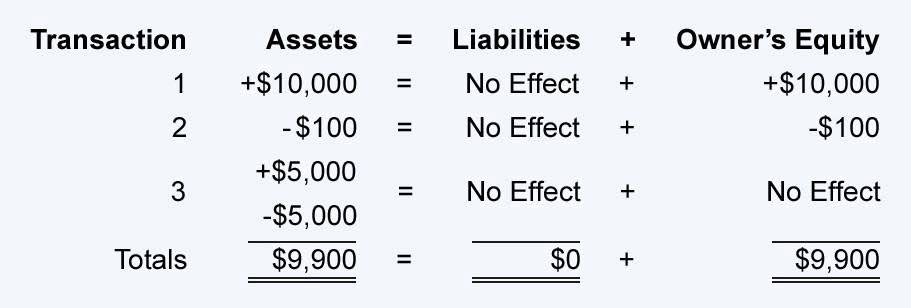How to Do Closing Entries? Step-by-Step Guide

IFRS started in 2001, taking over from the International Accounting Standards (IAS). This move helps companies across the world by Bookkeeping vs. Accounting making finalizing business financial activities simpler. Using IFRS can lead to recognizing income sooner than with GAAP.
- When the closing entries are posted, and the balances are update, the ledger will show zero balances for all revenue, expenses, and drawing accounts.
- Likewise, if a temporary account has a credit balance, it is debited to bring it to zero and the retained earnings account is credited.
- Adjusting entries ensures that revenues and expenses are appropriately recognized in the correct accounting period.
- We want to make sure we are accurately accounting for what we have (asset) and what we used (expense).
- When you compare the retained earnings ledger (T-account) to the statement of change in equity, the figures must match (i.e. the retained earnings account now has the correct balance at the end of the period).
- You may also see the account called Owner Name, Withdrawals or Owner Name, Dividends.
Step 4: Transfer the Income Summary Balance
To close that, we debit Service Revenue for the full amount and credit Income Summary for the same. Mortgages are a commonly used form of financing in property transactions. The mortgage is a liability since it is a debt we owe to the bank or other institution. When we first bought the property, we would have booked a debit to the property and a credit to cash. To remove the property from our books, we’ll do the same journal entry but in reverse.
Dividend Accounts and Closing Journal Entries
Another method used in some textbooks to create closing entries, uses a temporary account called Income Summary. Income Summary acts as a “bucket” to move amounts out of Revenue and Expenses. Income Summary is then closed out to the Capital or Equity closing entries or Retained Earnings accounts. The final step is to close the Drawing account to the Capital account. Expense accounts are closed by transferring their balances to the Income Summary account.
- These permanent accounts show a company’s long-standing financials.
- An adjusted trial balance contains nominal and real accounts.
- By integrating a journal entry management module, as found in the Highradius suite, organizations can automate the creation and management of journal entries, drastically increasing efficiency.
- These accounts will not be set back to zero at the beginning of the next period; they will keep their balances.
- It lists the current balances in all your general ledger accounts.
Step 1: Clear revenue to the income summary account
- They are vital to report revenue and expenses in the correct period.
- We’ll explore how closing entries can successfully depict your business’s achievements as you move forward.
- The assumption is that all income from the company in one year is held for future use.
- The platform instantly flags unmatched transactions, assigns contextual reasons, and routes them to the right team members.
- Once ingested, every transaction is automatically matched, closed, and updated in-platform using advanced logic-based matching that supports one-to-many and many-to-one configurations.
- For partnerships, each partner’s drawing account is closed to their individual capital account.
Closing entries are also made after adjusting entries, which are used to update accounts before financial statements are prepared. Permanent accounts, in contrast, are the sturdy oaks, steadfast year after year. They consist of assets, liabilities, including ignored accrued expenses as a form of permanent liability account, and most equity accounts entries that show the ongoing financial state of an entity. Their balances carry over into the next accounting period, providing a continual financial narrative. This highlights the inherent stability of equity account entries, which remain unaffected by closing entries and ensure the equity accounts reflect the long-term financial health of the business. By resetting temporary accounts and retaining the balances of permanent ones, businesses ensure that each period’s books begin with a clean slate while tracking the progress of cumulative deductions over time.

Can accounting software like QuickBooks help with closing entries?
Prepare the closing entries for Frasker Corp. using the adjustedtrial balance provided. Printing Plus has a $4,665 credit balance in its Income Summaryaccount before closing, so it will debit Income Summary and creditRetained Earnings. However, if the company also wanted to keep year-to-dateinformation from month to month, a separate set of records could bekept as the company progresses through the remaining months in theyear. For our purposes, assume that we are closing the books at theend of each month unless otherwise noted.
What is an Asset?
When the period ends, you don’t just want to know the totals—you need the numbers to be 100% right because even small mistakes can snowball into major problems. Say you’re running a freelance design business and have earned $50,000 in revenue this year. Explore why HighRadius has been a Digital World Class Vendor for order-to-cash automation software – two years in a row. Download our data sheet to learn how you can manage complex vendor and customer rebates and commission reporting at scale.

If you have never followed the full process from beginning to end, you will never understand how one of your decisions can impact the final numbers that appear on your financial statements. You will not understand how your decisions can affect the outcome of your business. The expense accounts have debit balances so to get rid of their balances we will do the opposite or credit the accounts. Just like in step 1, we will use Income Summary as the offset account but this time we will debit income summary.


Right now, our Supplies account says we have $3,300 worth of supplies in the supply closet, but this is no longer accurate. Yes, accountants sometimes use reversing entries at the beginning of a new period to simplify bookkeeping for accruals and adjustments. Because most accounting is done now using accounting software, Closing Entries happen behind the scenes.
Journal Entry
As you wave goodbye to the accounting period, you, the business owner, must reconcile any withdrawals. To clean the slate, the balance of the drawing account is transferred to the capital account, decreasing its balance. Learning how to navigate these transactions is a key concept in any comprehensive accounting course.

After these entries, all temporary accounts (revenue, expenses, dividends) will have zero balances, bookkeeping and the net income and dividends will be reflected in the Retained Earnings account. To do this, we will do the opposite of the balance in the adjusted trial balance in a journal entry and use Income Summary to balance the entry. At this point, the accounting cycle is complete, and the business can begin a new cycle in the next accounting period. It is worth mentioning that there is one step in the process that a business may or may not include, step 10, reversing entries. Reversing entries reverse an adjusting entry made in a prior period at the start of a new period.
